How to Edit Photos Like a Pro in 2026: The Ultimate Editing Guide for Photographers
I’ve been a professional wedding photographer for close to eight years now, and something I learned very early on is that the ‘perfect photograph’ in-camera is still not a completed image. The finished product comes from editing.
Editing wedding photos is where you can refine, enhance, and transform your images from flat files to album-worthy artworks for your clients. Whether you’re new to the wedding photography journey or fairly seasoned, understanding how to edit photos like a pro is crucial.
A professional photo editing workflow in 2026 usually starts with an AI baseline and ends in Lightroom.
I’m Paul Waring, a UK-based wedding photographer. In this guide, I’ll walk you through the essential steps and tools you need to learn how to edit photos like a professional and master photo editing for wedding photography. From choosing the right software to incorporating modern and useful AI tools, this comprehensive guide will help you streamline your workflow and create stunning results.
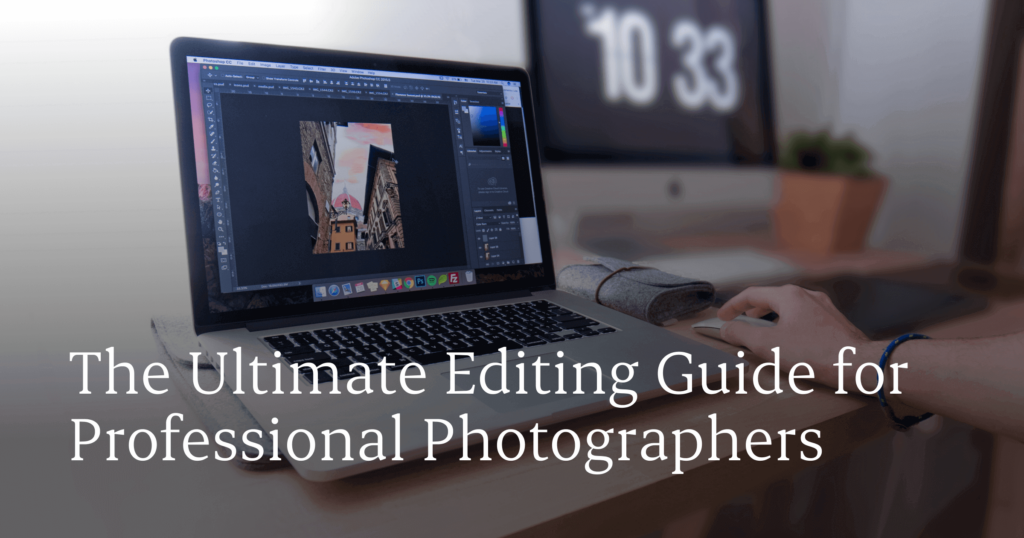
Things to do Before Editing
1. Back up Your Images
When it comes to dealing with what is perhaps the biggest day of our clients’ lives, the stakes are high, and we need to ensure we’re prepared with a solid backup solution. For me, this is absolutely non-negotiable. Losing client photos could potentially destroy a wedding photographer’s reputation or even career.
From the moment you click the shutter, you need to think about how safe your files are. My photographs are always written to two memory cards in the camera. When I’m at my computer, my goal is to then have three copies of the files: my working files, one backup drive, and one stored off-site. In my case, the off-site backup is in the cloud.
2. Cull your Photos
Once you’re confident your photos are backed up, it’s time to cull. At weddings, we can shoot thousands of images, and not all of them will be delivered to the client. Culling is the process of selecting the best photos from a larger set. This can be daunting, so having an efficient workflow can save hours of your precious time.
There are a few popular approaches to culling.
a) Cull within Lightroom
Lightroom can be a powerful tool for culling and is great if you want to keep everything within the same program. You can quickly flag or rate your photos and immediately start editing your favorites.
My tip is to use Smart Previews within Lightroom, as this will make it quicker to sift through the images. The downside is that Lightroom can be slower than a dedicated culling program, especially when dealing with the large number of photographs we shoot at weddings.
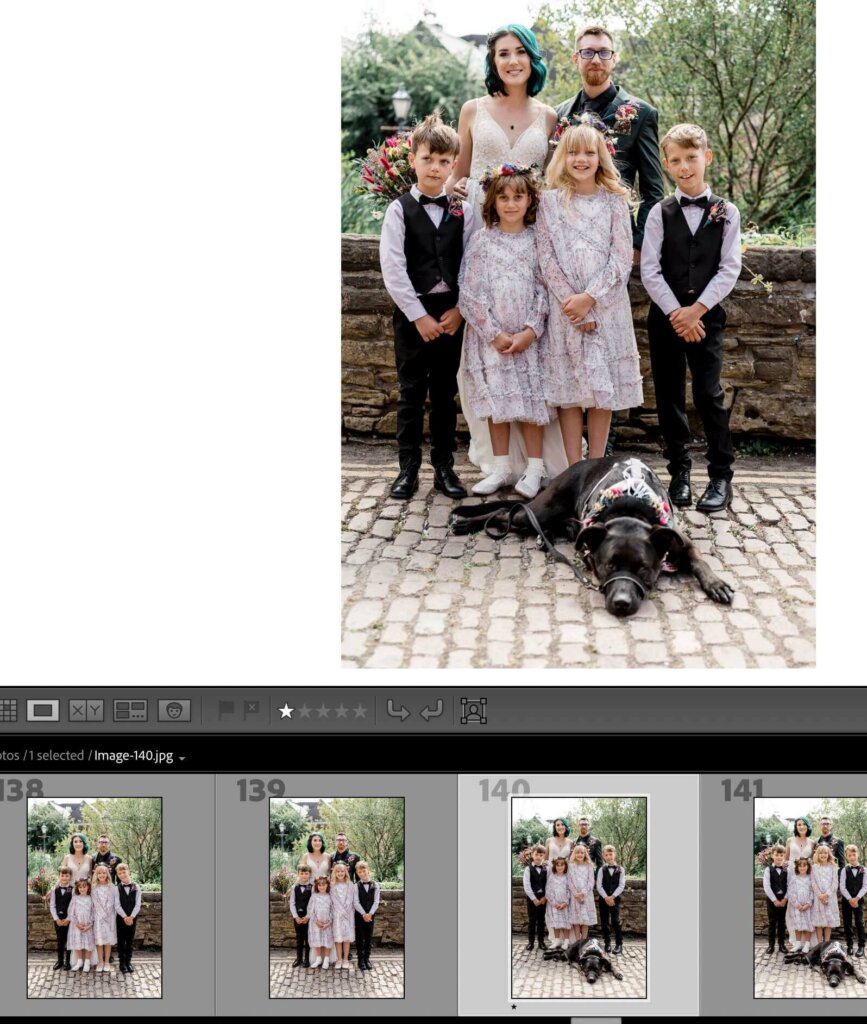
b) External Culling Programs
If, like me, you find Lightroom’s culling process a bit sluggish, external programs can speed up the process. A classic favorite for many wedding photographers is Photo Mechanic, although newer software exists. This software is great for handling a large number of images without lagging. You can then import only the selected images into Lightroom.
c) AI Culling Tools
More recently, new AI tools have emerged to assist with the culling process. AI culling software like Aftershoot analyzes your images and helps decide which photographs are the best. This has recently become my preferred option. I can drastically reduce the time spent culling while still casting my final judgment on which photographs I’ll be editing.

3. Keep File Names, Folders, and Backups Predictable
I will quickly touch on organization. For the sake of your future self, organizing your images is crucial. Create a folder structure that is logical to you, such as organizing by date, event, or client name. Keep this consistent.
I like to organize my files in a large folder by year. I then break this down into subcategories like ‘01. Katie & Andrew’ and ‘02. Joanne & Michael.’ Within these folders, I keep subfolders for RAW files, selected images, and the exported JPEG files once edited.
A well-organized photo library not only saves time but also helps you stay focused on the creative aspects of editing rather than getting bogged down in administrative tasks.
4. Set up Your Physical and Digital Workspace
A professional photo editing workflow in 2026 starts before the first slider moves. Creating an efficient and comfortable workspace is crucial, as it enhances both productivity and the quality of your work. I also like to make my office a pleasant place to spend time.
Start by investing in a supportive chair, a spacious desk, and proper lighting to reduce eye strain and accurately view colors. Organizing your physical workspace to minimize distractions allows you to focus fully on your editing tasks.
In Lightroom, you can collapse and hide the tools you don’t use. I prefer to use the Develop tools in ‘Solo Mode,’ which lets you concentrate on the specific tools you’re working with.
It’s worth investing in a computer with enough processing power and RAM to handle your camera’s files without struggling, enabling you to work quickly.
Speaking of not struggling and working quickly, we recently conducted a survey of over 1000+ pro photographers across the world and found that 81% of photographers who adopted AI in their workflows had reclaimed work-life balance in 2025!
Aside from work-life balance, they are also using the time AI saves them to curate personalized, premium client experiences, unique artistic styles, and delivery models that command premium pricing.
Get the full scoop and steal their playbook from this free report:

Some of the Additional Software and Tools Photographers Use for Editing
Additional software and physical tools can further enhance your photography workflow. Plugins offer advanced filters, effects, and AI-powered enhancements that can save time and add creative options to your edits. These plugins integrate seamlessly with Lightroom, giving you more control and flexibility in achieving your desired look.
Physical tools like the TourBox and Loupedeck can also significantly improve your editing efficiency. These nifty devices provide customizable dials, buttons, and knobs that offer tactile control over Lightroom’s functions, allowing for quicker adjustments. I personally use the TourBox, which speeds up my photo editing workflow and reduces strain from repetitive mouse movements, making the editing process smoother and more intuitive.
What do Professionals Use to Edit their Photos?
Professional photographers use a variety of powerful photo editing software to enhance their images. A staple in the photography world, Adobe Lightroom is ideal for batch editing, color correction, and basic retouching. Capture One, Affinity Photo, and Skylum Luminar are some of the other editing software that professional photographers use
What are the Editing Alternatives to Adobe Lightroom?
This article is mainly geared towards editing with Adobe Lightroom. Lightroom is the most popular RAW editing software used by professionals, including myself. However, it’s not the only option. You may also want to check out Capture One or Affinity Software. My experience with these is limited, but most editing programs have similar core functions and will create similar results in different ways.
How to Edit Photos Like a Professional in 7 Steps
1. Import Your Images
The first step in any editing workflow is importing and organizing your photos. In Adobe Lightroom, start by importing your images. I like to do this after the images have been backed up and culled. As you import, you can add metadata, keywords, and copyright information. This not only helps with future searches but also protects your work.
You can select the size of your previews. I find ‘standard’ previews work well for me. I also like to create smart previews, as this allows me to work faster.
If you already use Aftershoot, processing happens locally so there's no upload time or bandwidth lag.
2. Basic Adjustments
Basic adjustments (highlighted red in the image below) are the foundation of your editing process. Start with the Exposure slider to correct overall brightness, followed by Contrast to add depth. Next, adjust Highlights and Shadows to recover detail in bright and dark areas, and fine-tune Whites and Blacks to set the dynamic range.
You can use the Clarity slider to add midtone contrast, giving your image a punchier look, but be careful not to overdo this. These adjustments set the stage for more detailed editing, ensuring your image has a balanced and polished appearance.
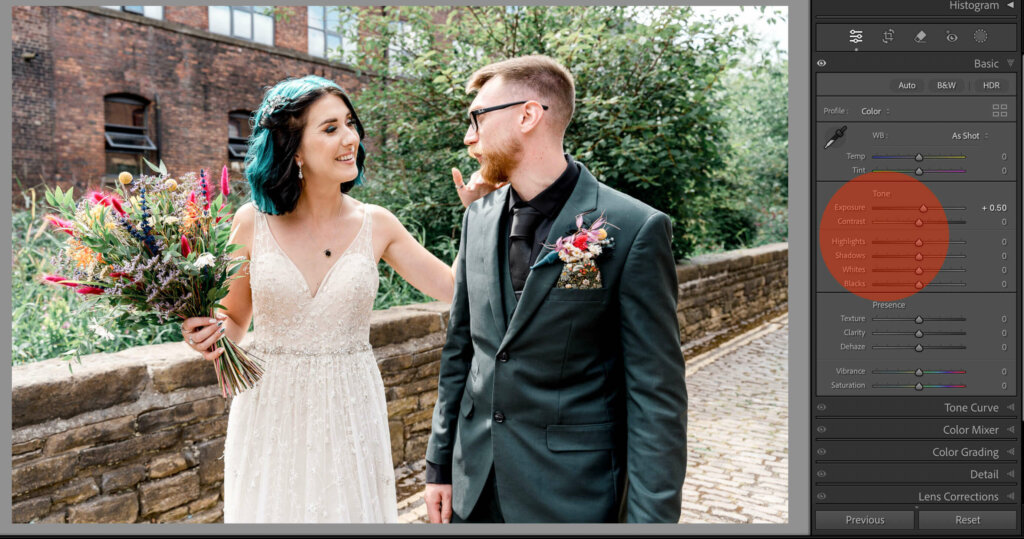
3. Cropping and Straightening
Cropping and straightening are essential steps to perfect your composition. In Lightroom, use the Crop Overlay tool to remove distractions or to focus on your subject. Consider using the rule of thirds or other compositional guides to improve the framing.
If the horizon is slightly tilted, use the Straighten tool to correct it. You can also manually rotate the image or use the Auto function to let Lightroom straighten it for you. Cropping and straightening not only enhance composition but also help to maintain consistency across the clients images.
Pro tip - Use the ‘R’ key to quickly enter the crop tool.
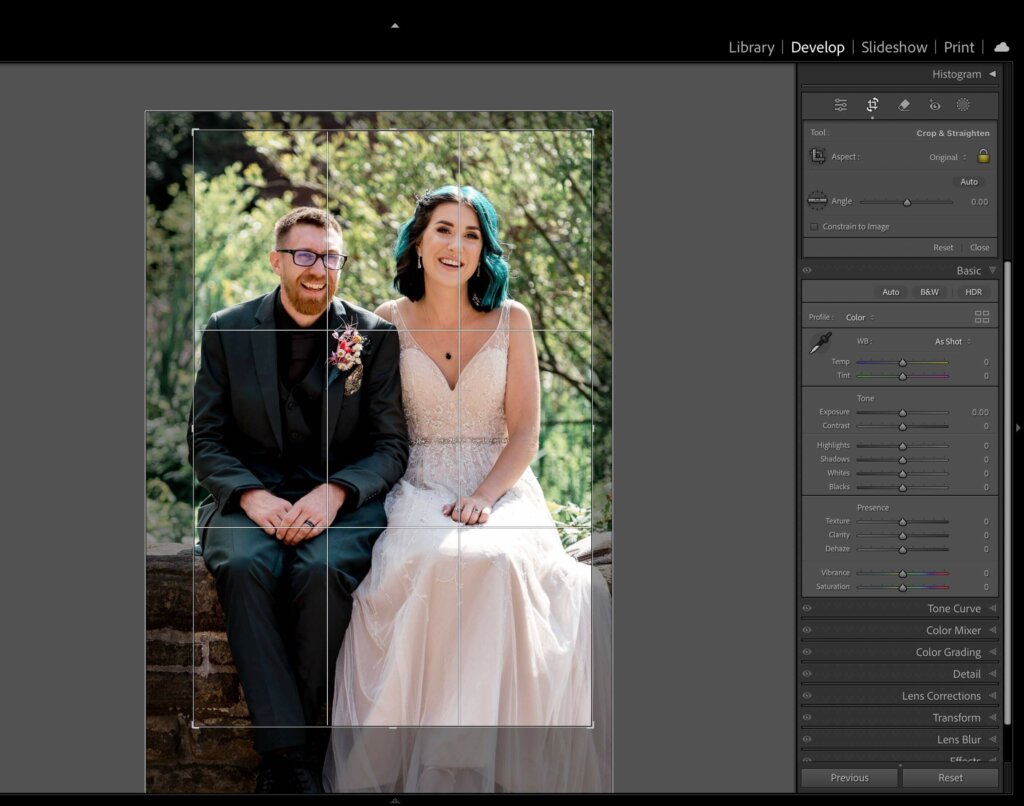
4. Keep Skin Tones and Color Consistent Across Light Sources
Color correction is crucial for creating a consistent and appealing look in your images. For portrait work, pay attention to how well your editor maintains skin tone under mixed light. Aftershoot’s AI Profiles help keep that tone consistent across scenes and lighting changes.
Start by fine-tuning the Temperature and Tint sliders to achieve the desired warmth or coolness. You can also try a white balance preset, such as Daylight or Shade (pictured below).
Next, use the Vibrance and Saturation sliders to enhance colors, being careful not to overdo it. If necessary, use the HSL panel to selectively adjust individual colors, ensuring skin tones and other key elements are natural.
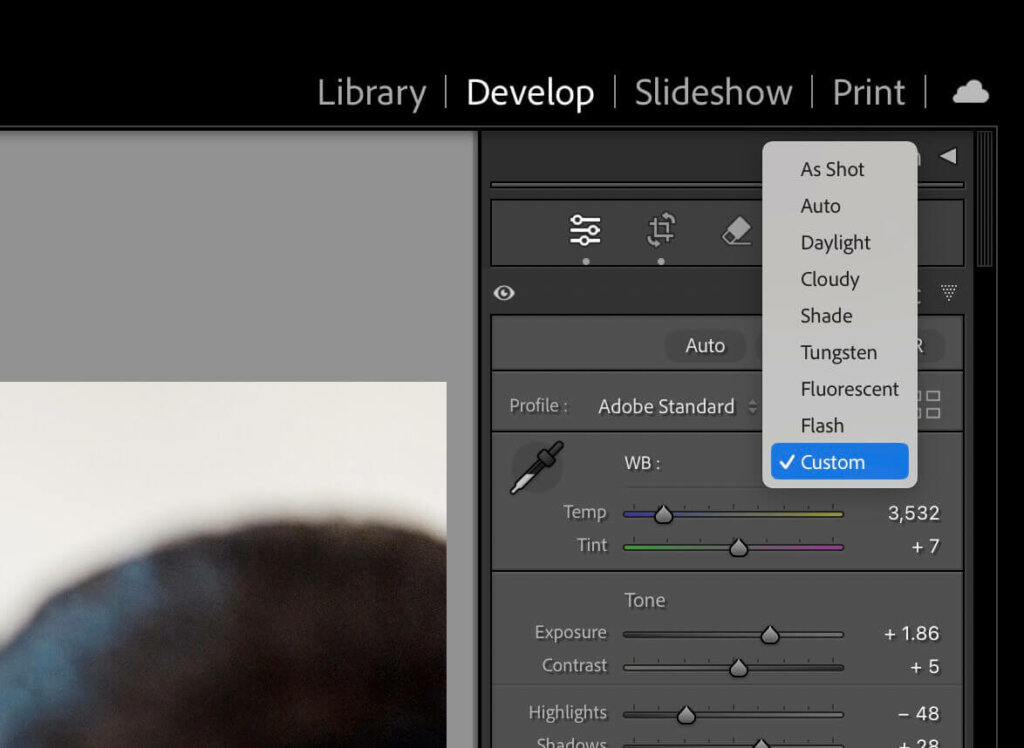
5. Fine Tuning, Masking, and Local Adjustments
Once the global adjustments are done, it’s time to fine-tune your image with local adjustments. In Lightroom, tools like the Adjustment Brush, Radial Filter, and Graduated Filter allow you to target specific areas for enhancement. Whether it’s adding a touch of brightness to the bride’s face or darkening the sky for more drama, these tools give you precise control.
You can also use Masking to apply adjustments selectively, ensuring that only certain parts of the image are affected. I keep saying this, but be careful not to overdo it. The image should look refined, but not overly edited.
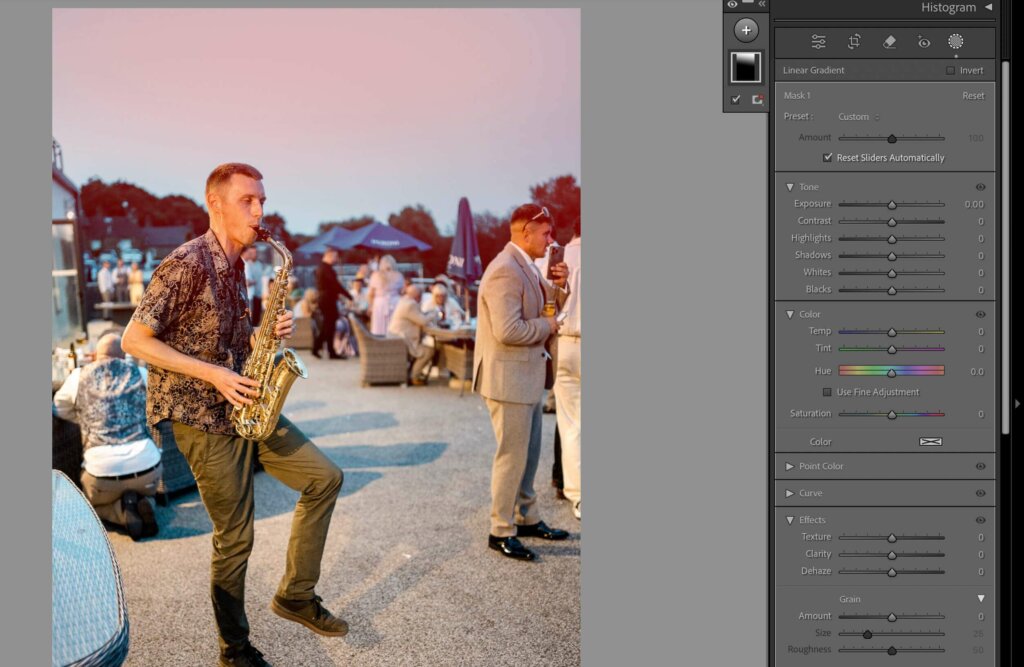
6. Sharpening and Noise Reduction
Sharpening and noise reduction are the finishing touches that can significantly enhance the quality of your images. In Lightroom, use the Detail panel to apply sharpening, focusing on bringing out the fine details without making the image look overly crisp.
Adjust the Radius and Detail sliders to control how sharpening is applied, and use the Masking slider to protect areas that don’t need sharpening. For noise reduction, increase the Luminance slider to reduce graininess in the image, especially in low-light shots. Balance these adjustments carefully to maintain a natural look.

7. Final Touches
The final touches bring your edit together and prepare your image for export. Review your image at full screen (use the ‘F’ key), checking for any remaining spots or distractions using the Spot Removal tool.
Consider adding a subtle vignette using the Effects panel to draw attention to the center of the image. If your image will be printed, ensure it’s in the correct color profile and consider soft proofing to see how it will look in print.
Finally, export your images with the appropriate settings for your intended use, whether for print, web, or client delivery.

Lightroom Presets - Should You be Using Them?
Editing presets in Adobe Lightroom are a powerful tool that can significantly speed up your workflow and help you achieve a consistent look across your images. Presets are essentially pre-configured settings that you can apply to your photos with a single click, instantly adjusting parameters like exposure, contrast, color balance, and more.
Also check out Lightroom wedding presets for photographers
Whether you’re working with your own custom presets or those created by other photographers, they can be a game-changer in your editing process.
As a wedding photographer, the reason I use presets is to maintain a consistent aesthetic across an entire set of photographs. For example, if you want all the images from a wedding to have a warm or desaturated feel, applying a preset design for that look can quickly set the tone for your edits.
Lightroom also allows you to fine-tune the presets after applying them, so you can make minor adjustments to suit each individual photo. This flexibility makes presets a great starting point, saving time on repetitive tasks while still allowing room for creative decisions.
By applying various presets to the same image, you can quickly see how different looks might enhance your photo. This is especially useful when you’re trying to define your personal editing style.
I personally have a set of personalized presets, which I can call upon in different scenarios. While they should not replace manual adjustments entirely, presets can serve as a valuable starting point in your editing, helping you achieve greater efficiency.
Use AI Photo Editing Tools to Speed Up Your Workflow
What is AI Editing?
AI editing has become an essential tool for myself and many industry friends, offering efficiency and consistency that was hard to get manually. AI editing uses machine learning algorithms to analyze and adjust your images based on patterns and preferences, often with just a few clicks for setup. AI editing can save countless hours.
AI Tools Within Lightroom
Adobe Lightroom has embraced AI with several powerful features designed to streamline your workflow.
Tools like Enhance Details and AI Noise Reduction use advanced algorithms to automatically refine your images, bringing out the best in certain scenarios. AI Noise Reduction has been a game-changer in improving the quality of low-light wedding shots, reducing noise without messing around with the detail.
The Enhance Details feature, on the other hand, helps me to achieve sharper, more defined images with just a click, particularly useful when dealing with intricate bridal gowns.
2026 update: Lightroom’s AI suite now includes Generative Remove, Lens Blur, and Reflection Removal (in Camera Raw preview). They handle object cleanup, realistic depth-of-field, and reflection fixes directly inside Lightroom without round-tripping to Photoshop.
Stand-Alone AI Editing Software
Beyond Lightroom, stand-alone AI editing software like Aftershoot has completely changed the way I approach my editing. Aftershoot’s AI-driven culling and editing features let me quickly sort through thousands of wedding photos, automatically picking out the best ones without needing to check each image myself. This has saved me a ton of time on culling, so I can focus more on the creative side of editing.
Here’s how I use Aftershoot in my workflow:
Step 1: Culling
First, I import all my photos into Aftershoot. The AI quickly analyzes and sorts through my gallery, selecting and grouping the images based on factors like sharpness, composition, and even facial expressions. It’s like having an extra pair of eyes that’s never tired. I can then go in and select the final images that I want to deliver.

Step 2: Select Images
Next, I select the images by using Star Ratings and Color Labels to choose the images I want to edit

Step 3: AI-Driven Editing
After culling, I let Aftershoot apply my editing style. The software has learned how I typically adjust my images, so it replicates those edits across the selected photos. In 2025, Aftershoot introduced Instant AI Profiles, which convert your Lightroom presets into adaptive profiles in about a minute. The software also includes Retouching, a fast local cleanup tool that smooths skin and reduces distractions while preserving texture for the whole batch.
The image below shows the difference between an image edited completely by Aftershoot vs the original file.
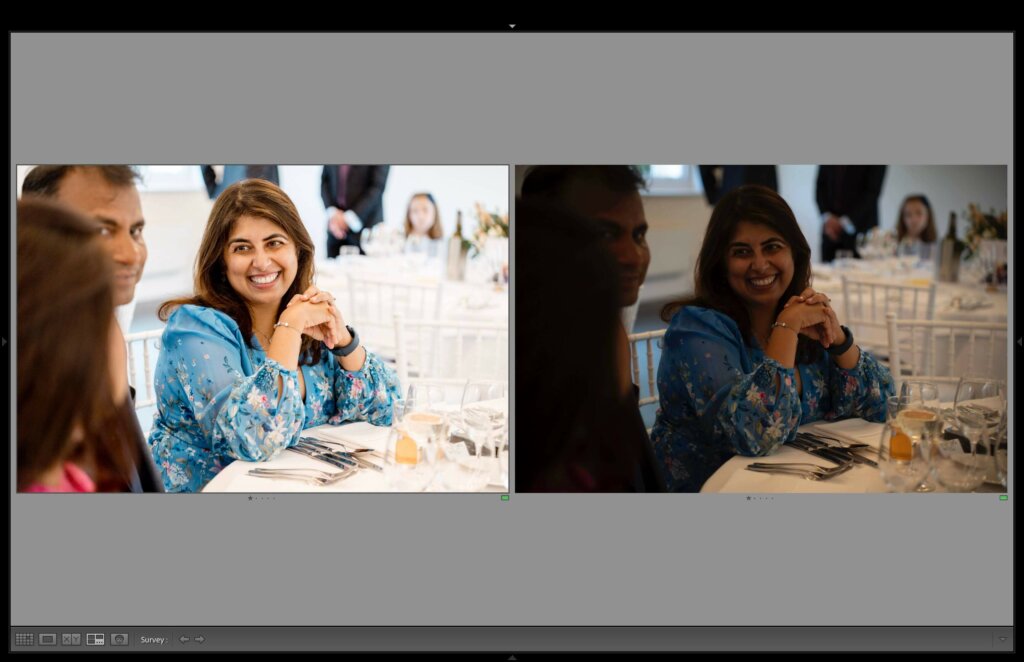
Once the AI pass is complete, open the results in Lightroom for detailed color control or creative grading.
Step 4: Finish and Refine in Lightroom
Once Aftershoot has worked its magic, I import the edited photos into Lightroom. Since Aftershoot has already applied my general style, I just need to make a few minor tweaks, like fine-tuning the color balance for something creative or different.
Edits, ratings, and metadata from Aftershoot carry over automatically, so everything stays organized once you return to Lightroom for finishing touches. With most of the heavy lifting done, these final adjustments are quick and easy, especially using my Tourbox for assistance.
This process has really streamlined my workflow. With Aftershoot handling a lot of the repetitive tasks, I can deliver consistent, high-quality results without spending endless hours in front of the screen.
Balancing AI with Manual Editing
While AI tools offer incredible convenience, it’s crucial to balance their use with manual editing to maintain full creative control, and know what to fix when it doesn't quite get things right. I view AI as a personal editing assistant, one that can handle repetitive and time-consuming tasks but still leaves artistic decisions in my hands.
By combining Aftershoot’s efficiency with my own adjustments, I ensure that every image reflects my unique style and meets my professional standards. AI can enhance your workflow, but it’s your creative vision that ultimately defines the final product.
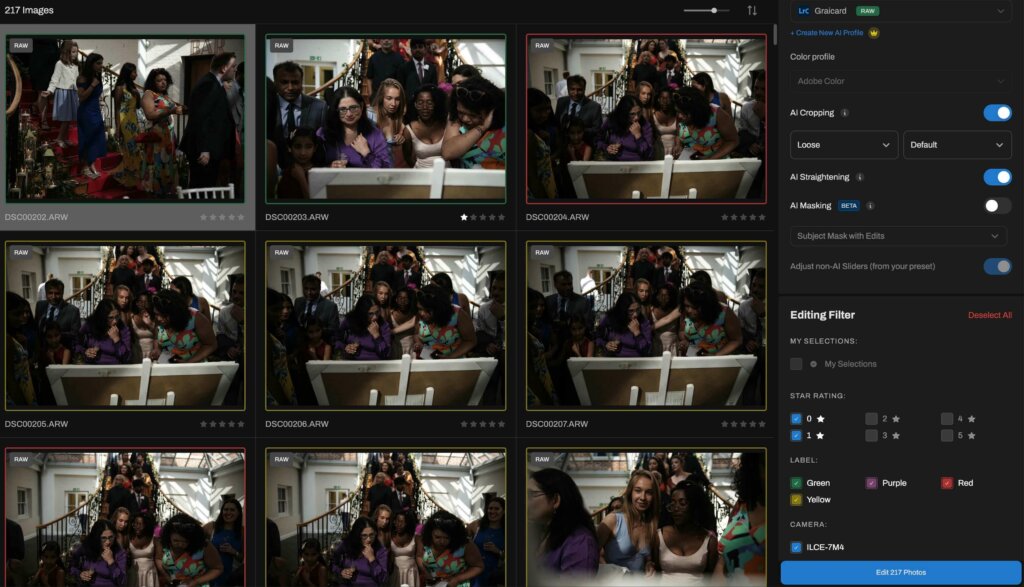
Enhance Your Photo Editing Workflow
AI photo editing tools have become a game-changing tool for professional photographers, helping streamline workflows and enhance image quality. However, it’s important to remember that while these tools can save time and improve efficiency, they are most powerful when used in conjunction with your own creative insights.
These workflow tips apply whether you shoot weddings, portraits, or commercial sets.
I encourage you to explore how AI can complement your editing process, and if you’re looking to take your workflow to the next level, give Aftershoot a try. Like myself, It might just become your new favorite editing assistant.
Quick Answers to Common Editing Questions (2026)
What’s the fastest way to edit photos professionally in 2026?
Run AI baseline edits in Aftershoot, then refine color and tone in Lightroom for a consistent, fast professional workflow.
Which AI photo editor works offline for large jobs?
Aftershoot handles culling, editing, and retouching locally, so you can edit thousands of RAW files without uploads.
How do professionals keep skin tones consistent across lighting?
Train an AI profile on past edits. Aftershoot’s Instant AI Profiles hold tone accuracy under mixed light; Lightroom finishes fine color control.
What new Lightroom AI tools matter in 2026?
Generative Remove for complex cleanup, Lens Blur for realistic depth, and Denoise for high-ISO work.
What’s the best AI photo editing software for photographers in 2026?
Aftershoot leads for full workflow automation, Lightroom anchors creative control, and Evoto handles advanced portrait retouching. Each fits a different need depending on speed, control, and scale.
How do you keep your editing style consistent across multiple jobs?
Build a repeatable process. Use the same baseline AI profile, reference frames, and color calibration. Aftershoot’s Instant AI Profiles and Professional AI profiles learn from your finished edits, keeping tone steady across shoots.
Is AI editing accepted by clients and publications?
Most clients care about turnaround and quality, not the method. As long as results stay natural and consistent, editors and clients rarely distinguish between manual and AI-assisted edits.
How are photographers pricing editing in 2026?
Many pros now factor AI efficiency into pricing—charging for delivery value, not hours spent. Aftershoot shortens editing time, allowing more bookings without discounting skill.
Do AI photo editors replace outsourcing or complement it?
For most professionals, AI replaces first-pass outsourcing. Aftershoot handles bulk editing locally, so you can reserve outsourcing budgets for specialized retouching or overflow work.
How can I make my workflow future-proof in 2026?
Keep file structure simple, adopt software that updates regularly, and rely on tools that learn your preferences. Aftershoot and Lightroom both evolve with new AI models while maintaining catalog stability.
